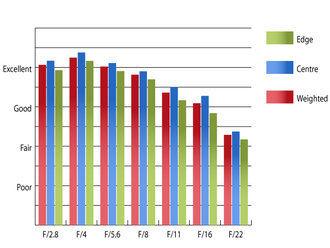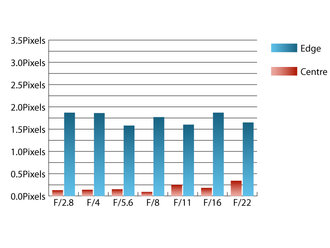Nikon 10.5mm f/2.8G ED DX Fisheye Interchangeable Lens
Nikon 10.5mm f/2.8G ED DX Fisheye Nikkor Performance
Sharpness at f/2.8 is excellent across the frame, with peak quality being achieved at f/4. Diffraction reduces sharpness as the lens is stopped down further, but clarity is still good across the frame down to f/11. Resolution at 10.5mm | How to read our chartsThe blue column represents readings from the centre of the picture frame at the various apertures and the green is from the edges. Averaging them out gives the red weighted column.The scale on the left side is an indication of actual image resolution. The taller the column, the better the lens performance. Simple. For this review, the lens was tested on a Nikon D300 using Imatest. |
Fisheye lenses often suffer with chromatic aberrations towards the edges of the frame, and the Nikon 10.5mm is no exception. Fringing approaching to pixel widths can bee seen along high contrast edges towards the edges of the frame, which may need correcting in image editing software afterwards.
 Chromatic aberration at 10.5mm | How to read our chartsChromatic aberration is the lens' inability to focus on the sensor or film all colours of visible light at the same point. Severe chromatic aberration gives a noticeable fringing or a halo effect around sharp edges within the picture. It can be cured in software.Apochromatic lenses have special lens elements (aspheric, extra-low dispersion etc) to minimize the problem, hence they usually cost more. For this review, the lens was tested on a Nikon D300 using Imatest. |
Falloff of illumination towards the corners of the frame is quite prominent at f/2.8 with the corners being 2.88 stops darker than the centre. Visually uniform illumination is achieved at f/5.6.
Add your message
Login required
Please login here or if you've not registered, you can register here. Registering is safe, quick and free.
Please login here or if you've not registered, you can register here. Registering is safe, quick and free.
photodo Stats
1102 lenses
428 MTF tests
74 in-depth photodo reviews
100+ users join each day
Help the lens community by reviewing or rating a lens today via our lens search
428 MTF tests
74 in-depth photodo reviews
100+ users join each day
Help the lens community by reviewing or rating a lens today via our lens search
Latest Lens Reviews
- Chinon 28mm f/2.8 Vintage Lens Review
- Canon EF 70-200mm f/4L IS II USM Lens Review
- Samyang AF 85mm f/1.4 EF Review
- Sigma 70mm f/2.8 DG Macro Art Review
- Samyang AF 24mm f/2.8 FE Review
- Meike 50mm f/1.7 Review
- Tamron 70-210mm f/4 Di VC USD Review
- Lensbaby Burnside 35mm f/2.8 Review
- Asahi Super Takumar 50mm f/1.4 Review
- Asahi Super-Multi-Coated Takumar 135mm f/3.5 Review
